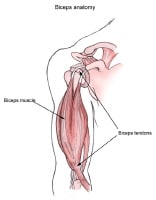Background
Bicipital tendinitis, or biceps tendinitis, is an inflammatory process of the long head of the biceps tendon and is a common cause of shoulder pain due to its position and function.[1, 2, 3, 4, 5] The tendon is exposed on the anterior shoulder as it passes through the humeral bicipital groove and inserts onto the superior aspect of the labrum of the glenohumeral joint. Disorders of the biceps tendon can result from impingement or as an isolated inflammatory injury. Other causes are secondary to compensation for rotator cuff disorders, labral tears, and intra-articular pathology.
For patient education resources, see the Arthritis Center and Sports Injury Center, as well as Tendinitis, Rotator Cuff Injury, and Repetitive Motion Injuries.
NextEpidemiologyFrequencyUnited StatesBicipital tendinitis is frequently diagnosed in association with rotator cuff disease as a component of the impingement syndrome or secondary to intra-articular pathology, such as labral tears.[6]
PreviousNextFunctional AnatomyAs its name implies, the biceps has 2 proximal heads with a common distal insertion onto the radius. The long head of the biceps merges with the short head of the biceps to form the body of the biceps brachii muscle. This muscle is a powerful supinator and flexor of the forearm.
The long head biceps tendon lies in the bicipital groove of the humerus between the greater and lesser tuberosities and angles 90° inward at the upper end of the groove, crossing the humeral head to insert at the upper edge of the glenoid labrum and supraglenoid tubercle. The long head of the biceps tendon helps to stabilize the humeral head, especially during abduction and external rotation.
See the image below.
 Biceps muscle and tendons. PreviousNextSport-Specific Biomechanics
Biceps muscle and tendons. PreviousNextSport-Specific BiomechanicsBicipital tendinitis frequently occurs from overuse syndromes of the shoulder,[7] which are fairly common in overhead athletes such as baseball pitchers, swimmers, gymnasts, racquet sport enthusiasts (eg, tennis players), and rowing/kayak athletes.[8, 9, 10, 11] Trauma may occur because of direct injury to the biceps tendon when the arm is passed into excessive abduction and external rotation. This pattern of shoulder injury can also occur in the left shoulder of right-handed golfers. Many overuse injuries coexist with some degree of bicipital tendinitis and rotator cuff tendinitis.
The athletic shoulder differs qualitatively from the biomechanics of the shoulder in daily life because of the higher energies and repetitive motions that are involved in athletic activities. Sports activities that require repetitive overhead motion with inadequate reparative time may cause the biceps tendon to break down.
PreviousProceed to Clinical Presentation , Bicipital Tendonitis






0 comments:
Post a Comment
Note: Only a member of this blog may post a comment.